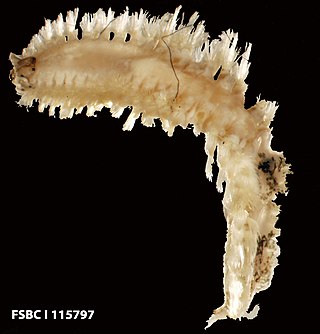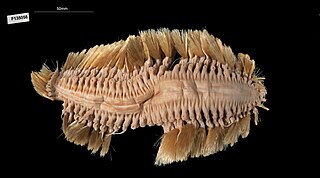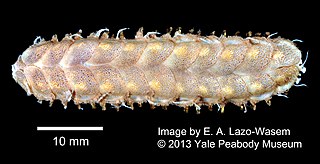
Nereis is a genus of polychaete worms in the family Nereididae. It comprises many species, most of which are marine. Nereis possess setae and parapodia for locomotion and gas exchange. They may have two types of setae, which are found on the parapodia. Acicular setae provide support. Locomotor setae are for crawling, and are the bristles that are visible on the exterior of the Polychaeta. They are cylindrical in shape, found not only in sandy areas, and they are adapted to burrow. They often cling to seagrass (posidonia) or other grass on rocks and sometimes gather in large groups.

Harmothoe is a genus of marine Polychaete worms belonging to the family Polynoidae. Species of Harmothoe are found world-wide to depths of at least 5,000 m but are more common in shallower water.

Phyllodoce is a genus of polychaete worms, which contains about 200 species. The prostomium bears eyes, two pairs of antennae and a pair of large retractile nuchal organs. The eversible proboscis is clearly divided into two parts.

Amphinomidae, also known as the bristle worms or sea mice, are a family of marine polychaetes, many species of which bear chaetae mineralized with carbonate. The best-known amphinomids are the fireworms, which can cause great pain if their toxin-coated chaetae are touched or trodden on. Their relationship to other polychaete groups is somewhat poorly resolved.

Arctonoe is a genus of worms in the family Polynoidae. They are commonly known as "scale worms". Members of this genus predominantly occur in shallow waters of the north-eastern Pacific Ocean and often live as commensals of other marine invertebrates, frequently echinoderms but sometimes molluscs or other polychaetes.

Eulagisca is a genus of marine polychaete worms belonging to the family Polynoidae. The genus includes 5 species which are all found in the Southern and Antarctic Oceans and are notable for reaching a large size - 180 mm or more long - larger than any other species of Polynoidae.

Eunoe is a genus of marine annelids in the family Polynoidae. The genus includes 48 species which are found world-wide, mostly from depths of 50 m or more.

Lepidonotus is a genus of marine annelids in the family Polynoidae. The genus occurs globally and includes 80 species, usually found in shallow waters down to about 80 metres.
Australaugeneria pottsi is a scale worm known from northern Australia from depths of 21m or less.
Eunoe sentiformis is a scale worm described from the East Siberian Sea in the Arctic Ocean.
Bathyeliasona is a genus of marine annelids in the family Polynoidae. The genus includes 4 abyssal and bathyal species which occur widely in the Atlantic, Pacific and Indian oceans, from depths of 2500 to 8000 m.
Benhamipolynoe is a genus of marine annelids in the family Polynoidae. The genus is known from the Pacific and Atlantic Oceans and includes 2 species.
Parahololepidella is a genus of marine annelids in the family Polynoidae. The genus contains a single species, Parahololepidella greeffi, This species is known from the east equatorial Atlantic Ocean and Cape Verde Islands at a maximum depth of 30m.
Bathynoe is a genus of marine annelids in the family Polynoidae. The genus includes 6 species, 5 of which occur in the Pacific Ocean while one occurs in the Atlantic Ocean. Bathynoe species have been recorded from depths of about 500 – 3000 m.
Austrolaenilla is a genus of marine annelids in the family Polynoidae. The genus includes 10 species which are known from depths of about 20 m to over 5000 m and from the Atlantic Ocean, Southern Ocean and Antarctic Ocean.
Eucranta is a genus of marine annelids in the family Polynoidae. The genus includes 5 species which are globally distributed from depths of about 40 to 600 m, mostly from high latitudes in the northern and southern hemispheres.
Gattyana is a genus of marine annelids in the family Polynoidae. The genus includes 11 species, 9 of which occur in the northern hemisphere, the remaining two are from the Indian Ocean off Mozambique and the Southern Ocean off New Zealand. Species of Gattyana are known from shallow water down to depths of about 1200 m.
Gattyana australis is a scale worm described from the Southern Ocean off New Zealand at a depths of 1100 to 1200 m.
Hermadionella is a genus of marine polychaete worms belonging to the family Polynoidae, the scaleworms. Hermadionella contains 3 species which are known from the north-west Pacific and Arctic Oceans from the intertidal to depths of about 200 m.
Subadyte mjoebergi is a scale worm known from a single specimen collected in the Indian Ocean off the coast of north-western Australia at a depth of 22 m.








